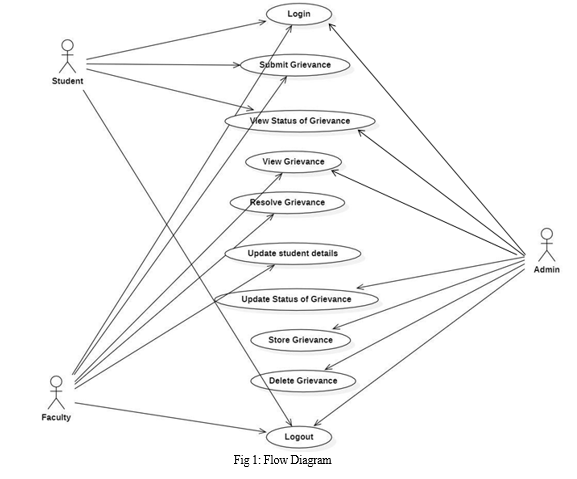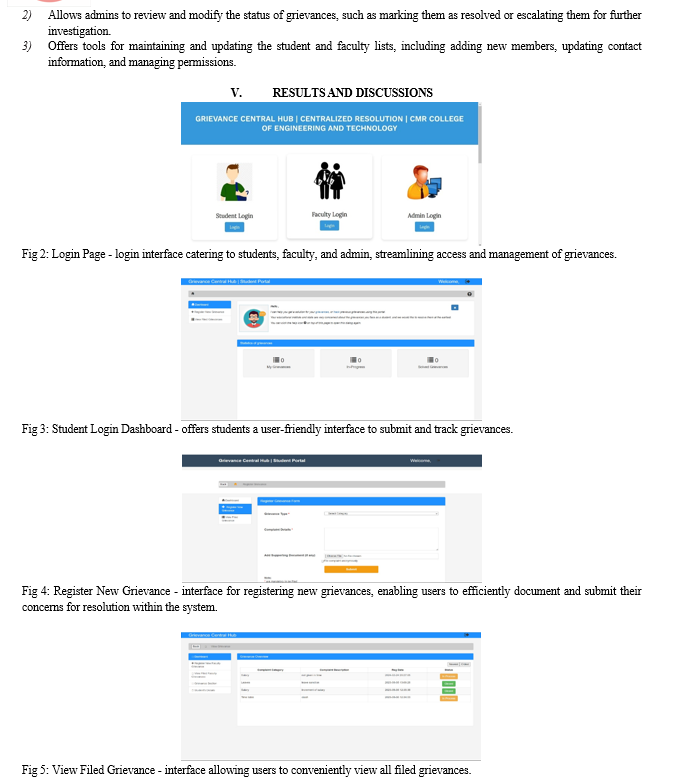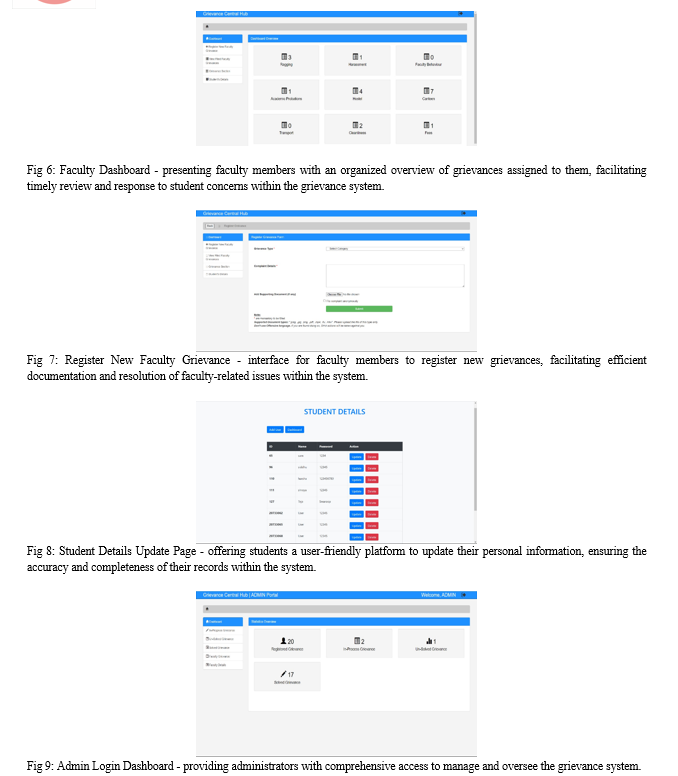Ijraset Journal For Research in Applied Science and Engineering Technology
- Home / Ijraset
- On This Page
- Abstract
- Introduction
- Conclusion
- References
- Copyright
Grievance Central Hub
Authors: Adki Ashlesha, Avanaganti Ujwala, Gundam Rohith Reddy, Jinugu Ranjith
DOI Link: https://doi.org/10.22214/ijraset.2024.59227
Certificate: View Certificate
Abstract
The Grievance Central Hub is a revolutionary approach to managing grievances within organizations. It offers a confidential, user-friendly, transparent system, fostering open communication and accountability. This portal efficiently handles grievances raised by individuals in the organization, promoting transparency and efficiency. Accessible to all with a user-friendly interface, it prioritizes security and confidentiality when handling complaints. Real-time tracking and updates on grievance status ensure that both students and faculty members are well-informed throughout the resolution process. The portal streamlines complaint management across various departments, providing a single point of contact for grievance submission. Powered by technologies like PHP, PHP mailer (for email communication), MySQL (for database management), Apache Tomcat, HTML, CSS, and JavaScript (for an interactive user interface), this system offers a seamless and responsive solution. It contributes to a more harmonious and accountable organizational environment, making grievance management efficient and effective.
Introduction
I. INTRODUCTION
A Grievance Central Hub is a comprehensive and streamlined digital platform designed to facilitate the submission, management, and resolution of grievances, complaints, and concerns within an organization, institution, or government body. This portal serves as a centralized hub where individuals, whether they are employees, customers, citizens, or other stakeholders, can submit their grievances electronically, track their progress, and receive timely updates on their resolution. The primary goal of a centralized grievance system portal is to enhance the efficiency, transparency, and fairness of the grievance-handling process. By consolidating all grievance-related activities into a single digital interface, the portal eliminates the need for individuals to navigate through multiple channels or departments, thus reducing complexities and administrative burdens. The objective of a centralized grievance system portal is to establish an efficient, transparent, and user-centric platform for managing and resolving grievances, complaints, and concerns within an organization. Our objective is to develop a centralized grievance system portal that streamlines the entire grievance handling process, from submission to resolution. Such a portal should provide a seamless, user-friendly interface that facilitates the submission of grievances, automates workflow management, and ensures clear communication at every stage.
II. LITERATURE SURVEY
The paper titled "A Web Portal for Student Grievance Support System" by Denny [1], presents a comprehensive solution for managing student grievances within educational institutions. Through the development of a web portal, the authors aim to streamline the process of grievance submission and resolution, enhancing transparency and efficiency in handling student concerns. The portal facilitates communication between students and administrators, allowing for the timely submission of grievances and real-time tracking of their resolution status. By providing a user-friendly interface, the system promotes open dialogue and accountability, ultimately contributing to a more harmonious organizational environment. In a similar vein, the paper titled "A Prototype for Grievance Redressal System" by Prajapat [2] introduces a prototype aimed at automating the grievance redressal process within organizations. The authors emphasize the importance of moving away from manual systems towards automated solutions to address the shortcomings of traditional grievance-handling methods. Through features such as online registration, user activation, and personalized communication, the system aims to improve the efficiency and effectiveness of grievance resolution. By automating various aspects of the grievance handling process, the prototype offers a solution to the challenges posed by manual systems, such as time-consuming processes and limited notification methods. Furthermore, the paper titled "Online Grievance Redressal System" by Buldak [3] presents an innovative approach to addressing grievances through an online platform. By leveraging technology, the authors propose a system that enables users to submit grievances electronically and track their resolution progress. The system aims to streamline the grievance redressal process, ensuring timely response and resolution to user concerns. Through features such as user-friendly interfaces and automated notifications, the online grievance redressal system offers a modern and efficient solution to the challenges faced by traditional grievance-handling methods.
III. EXISTING SYSTEMS
- Traditional paper-based grievance systems- These are deeply ingrained in the bureaucratic processes of many government organizations. In this method, citizens are required to fill out physical paper forms to report their complaints or grievances. These paper forms are subsequently processed and tracked manually by government agencies.
- Email and phone-based grievance handling- Some government agencies utilize email and phone-based methods to handle citizen grievances. In this approach, citizens can report their complaints and concerns through emails or phone calls, and government agencies designate human operators to manage these communications.
- Fragmented digital grievance platforms- Some government agencies have developed their digital grievance platforms, but these platforms are often fragmented and operate independently from each other. Each agency creates its own web-based or mobile-based system for citizens to report grievances. Example CPGRAMS (Centralized Public Grievance Readdress and Monitoring System)
A. Disadvantages Of Existing Systems
- Inefficient data management practices hinder the organization's ability to effectively organize and utilize its information resources.
- Limited data analytics capabilities restrict the organization's capacity to derive meaningful insights and make informed decisions from its data.
- A potential overload of information poses a risk of overwhelming the organization's systems and personnel, leading to inefficiencies and reduced productivity.
- Lack of centralization in data storage and management leads to fragmentation and duplication of efforts across different departments or systems.
B. Proposed System
- The portal provides two different types of accounts, one for users to submit their grievances and the other for the authorities/officials of different departments.
- Any user can create an account on our portal and then submit grievances.
- Grievances will then be submitted to the accounts of the appropriate officials, who will then try to resolve the issues.
- During this period, there will be constant updates on the status of the grievance on the user portal.
C. Advantages of Proposed Systems
- Provides a single point of contact for students to register complaints related to college.
- Improves transparency by allowing students to track the status of their complaints in real time.
- Streamline the complaint-handling process by providing a centralized platform for college officials to receive, investigate, and resolve complaints.
- Enhance the delivery of services by addressing the grievances of students and ensuring timely redressal of their complaints.
- The portal manages grievances efficiently by registering, tracking, monitoring, and resolution of conflicts.
IV. DESIGN METHODOLOGY
A. User Authentication Module
- Implements secure authentication protocols like OAuth or JWT to verify user identities during the login process. This ensures that only authorized users can access the system, enhancing overall security.
- Utilizes role-based access control (RBAC) to ensure that only authorized users can access specific features and resources within the system.
- Provides password hashing and encryption techniques to safeguard user credentials and protect against unauthorized access. By encrypting passwords and utilizing hashing algorithms, the module ensures that sensitive information remains secure even in the event of a data breach.
B. Student Dashboard Module
- Implements secure authentication protocols like OAuth or JWT to verify user identities during the login process. This ensures that only authorized users can access the system, enhancing overall security.
- Utilizes role-based access control (RBAC) to ensure that only authorized users can access specific features and resources within the system.
- Provides password hashing and encryption techniques to safeguard user credentials and protect against unauthorized access. By encrypting passwords and utilizing hashing algorithms, the module ensures that sensitive information remains secure even in the event of a data breach.
C. Faculty Dashboard Module
- Presents a consolidated view of all grievances submitted by students, categorized by status or priority level, to facilitate efficient management. This comprehensive view enables faculty members to prioritize and address grievances effectively.
- Enables faculty members to assign grievances to themselves or other faculty members for resolution, along with adding comments or updates. This feature streamlines the grievance resolution process by enabling faculty collaboration and communication.
- Offers feature for faculty to communicate with students regarding their grievances request additional information and provide status updates on resolution progress. By facilitating communication between faculty and students, the module fosters transparency and ensures timely resolution of grievances.
D. Admin Dashboard Module
1) Provides administrative functionalities for managing user accounts, including creating new accounts, resetting passwords, and deactivating inactive accounts. This administrative control ensures that user accounts are properly managed and maintained.



 ???????
???????
Conclusion
A Centralized grievance system portal can be a highly effective tool for managing complaints and grievances in a streamlined and efficient manner. By providing a single platform for individuals to register complaints, the system can help ensure that complaints are addressed promptly and appropriately. It has the potential to improve the handling of complaints and grievances and promote transparency and accountability. The application interface of the centralized grievance system portal provides a user-friendly experience, allowing individuals to easily register complaints and track their status. With intuitive navigation and responsive design, the application ensures accessibility across various devices and platforms. Through push notifications and alerts, users stay updated on the progress of their complaints in real time. Advanced security measures safeguard sensitive information and ensure confidentiality throughout the complaint resolution process. The student module allows for seamless complaint submission, tracking, and feedback, enhancing transparency and accountability in addressing student concerns. Faculty members benefit from a dedicated module that streamlines the management of academic-related grievances, fostering a conducive learning environment. The admin module provides centralized oversight and control, facilitating efficient resolution processes and ensuring compliance with regulatory standards. The future scope for a centralized grievance system portal is quite promising, especially as technology continues to advance and societies become more digitally interconnected. Such a portal can serve as a vital tool for efficient complaint handling, transparency, and accountability in various sectors, including government, business, education, healthcare, and more.
References
[1] J. Denny, R. Chanda, S. R. Lenka, A. S. Reddy, & Vallabhaneni. \"A Web Portal for Grievance Support System.\" In: Proceedings of the National Conference on Advancement of Technologies—Information Systems & Computer Networks (ISCON—2018), vol. 1, pp. 1–2, (2018). [2] Prajapat, S., Sabarwal, V., Wadhwani, V. \"Developing a Prototype for Grievance Redressal System.\" In: Proceedings of the National Conference on Advanced Computing Technologies, vol. 1, pp. 1–2, (2018) [3] Buldak, M., Pandhekar, S., Gigani, A., Kachwah, A. \"Design and Implementation of an Online Grievance Redressal System.\" Journal of Digital Governance, vol. 5, no. 2, pp. 123–136, (2019) [4] Misha, P.M., Sunny, R., Rahul, S. Shaligram, P.: \"Challenges associated with automation of NPO\"-requirement engineering phase. In: Qi, E., Shen, J., Dou, R. (eds.) Proceedings of the 21st International Conference on Industrial Engineering and Engineering Management 2014. pp. 665-669. Atlantis Press, Paris (2015). [5] Singh, C.P... “Ragging: a human rights abuse”. Indian J. Dev. Res. Soc. Action 7(1-2), 17-30 (2011) [6] Anju, T.: “Incidents of sexual harassment at educational institutions in India”- preventive measures and grievance handling. Int. J. Res. Rev. Health Sci. Recent Adv. Multidisc. Res. 2. 317-322 (2015) [7] Subhash, C, Ashwani K: “Assessing grievances redressing mechanism in India.” Int. J. Compute. Appl. 52(5), 12–19 (2012) [8] Nripendra, P.R., Yogesh, K.D., Michael, D.W., Vishanth, W.: “Investigating success of an e-government initiative” - validation of an integrated IS success model. Inf. Syst. Front. 17(1), 127–142 (2015) [9] Dipankar, M.: “Solution towards effective complaint registration system in Indian scenario.” In: IJCA Proceedings on National Conference on Advancement of Technologies—Information Systems & Computer Networks (ISCON—2012), vol. 1, pp. 1–2 (2012)
Copyright
Copyright © 2024 Adki Ashlesha, Avanaganti Ujwala, Gundam Rohith Reddy, Jinugu Ranjith. This is an open access article distributed under the Creative Commons Attribution License, which permits unrestricted use, distribution, and reproduction in any medium, provided the original work is properly cited.

Download Paper
Paper Id : IJRASET59227
Publish Date : 2024-03-20
ISSN : 2321-9653
Publisher Name : IJRASET
DOI Link : Click Here
 Submit Paper Online
Submit Paper Online

